
Bush food tips from a Feisty Tasmanian
By Gabrielle Stannus
Rees Campbell is well-known in lutruwita/Tasmania for Eat Wild Tasmanian, her seminal work on native edible plants first published in 2018 and revised and expanded as Eat More Wild Tasmanian this year. Rees describes herself as a Tasmanian by birth and attitude, and she is passionate about promoting the value of the marvellous bounty found within this state’s bush. Her first memories of edible native plants stem back to her childhood, eating wild foods including native cherries (Exocarpus cupressiformis). Here Rees shares her tips for incorporating Tasmanian native edible plants, many of which can also be found on the mainland, into both public and private gardens and landscapes.
“The incorporation of native plants into our landscapes is important for a range of reasons,” says Rees, “Native plants provide habitat for native birds and animals, a food source for pollinators, and it maintains the natural biodiversity of a region rather than an introduced one. These are plants that are already suited to the local environment. To incorporate native edible plants in any form of landscape design is to me just an extension of what already exists for food gardens.”
Rees and her partner Col live on a suburban block they call the ‘Murnong Wild Food Garden’ in Wynyard on Tasmania’s northern coast. At Murnong, named after the yam daisy Microseris lanceolata, Rees and Col grow over 120 species of Tasmanian edible plants, as well as introduced varieties including lettuce, apples, tomatoes, and berries. They also breed free-range guinea pigs and quail to provide meat and eggs in their diet.
Make native plants part of the norm
“We really need to start integrating our Tasmanian plants as part of the normal garden. We are quite happy to eat Greek Fetta and Turkish Delight. However, we do not eat ‘Tasmanian’,” says Rees. She promotes the flavours of wild Tasmanian food through her Feisty Tasmanian preserves, including chutneys, sauces, dukkas, teas, jams, and jellies. “All our products are made from a mixture of traditional, introduced ingredients and native Tasmanian plant ingredients. Everything that I sell or make, apart from flour and sugar, is grown in our own garden,” Rees explains.
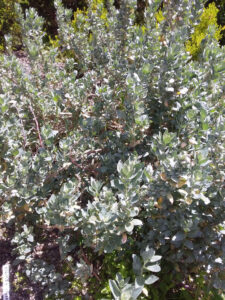
Saltbush city limits
In this very urban setting, Rees loves growing Atriplex cinerea (Saltbush) for its versatility. Rees says that saltbush was almost killed out by the early European settlers here in Tasmania because they burnt it with seashells to make lime for building, and they also recognized its edible properties and therefore ate it! Rees selects saltbush for its salty flavouring and green colouring, cooking and crushing its leaves for use in breads, pastries, and biscuits. I was fortunate enough to taste Rees’ ‘tempura-battered coastal leaves’ over lunch late last year where she perfectly paired fried saltbush leaves with her wonderful preserves. Delicious!
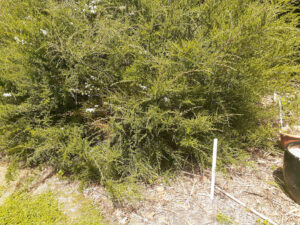
Consider Kunzea
Another one of Rees’ go-to plants in the garden is Kunzea ambigua (Sweet Scented Kunzea/tinputina). “Every part of that plant is edible, including the foliage and flowers. You can even make botanical scents and creams from it,” explains Rees. She is not the only one who loves the kunzea in her garden. “Insects absolutely love kunzea when it is flowering. It is a mass of different insects. It is also a dense bush, so birds use it as a nesting habitat. Then you have all sorts of skinks and other animals in there eating the insects,” says Rees.
Start with some herbs
If you or your client only want to grow a few Tasmanian edible native plants in a garden, then Rees recommends starting off with some of the herbs, Apium prostratum (Sea Parsley), Apium insulare (Sea Celery), Tasmannia lanceolata (Mountain Pepper/tapu), Ozathamnus obcordatus (Native Thyme) or Olearia axillaris (Native Rosemary, Bluebush or Coast Daisybush). These herbs look good in the garden and add a distinctive Australian flavour to contemporary meals.
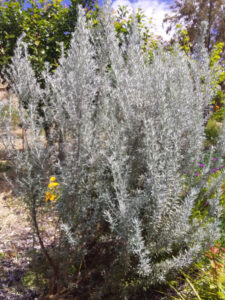


Edible can be ornamental!
A garden planted with native edible plants is not just tasty, but can be very easy on the eye too, as evident in Murnong, Rees’ home garden. Rees and Col have carefully positioned plants to take advantage of the unique micro-climates and soils found on their block, and for their viewing pleasure from strategic vantage points. The plant palette here features the beautiful silvery foliage of species including Olearia axillaris and the saltbush, Atriplex cinerea. “Saltbush is now planted in centre strips of highways in New South Wales because it reflects light, so drivers know where the barrier is,” says Rees.
Many edible native plants possess attractive flowers which can enhance the aesthetic appearance of a garden or landscape. Rees adores Carpobrotus rossii (Pigface/kanikung), the sturdy groundcover with numerous light purple petals (technically staminodes), as in her opinion this plant produces the best fruit for eating. Also consider the native bluebells (Wahlenbergia spp.) and Golden Bulbine-lily (Bulbine bulbosa) for their floral appeal and edible flowers. Many of these species grow naturally here in Tasmania and throughout much of southern mainland Australia.
Think of grass or heathlands instead of meadows
Rees suggests that designers looking to achieve a ‘meadow’ effect full of wildflowers consider using native grasses or heath plants instead. “Heathlands are one of the most biodiverse environments there are in Australia. There are oodles of edible plants in them. Edible (but protected) heathland plants include all the orchids, lilies e.g., Arthropodium strictum, Chocolate Lily, lots of leptospermums and melaleucas including Melaleuca gibbosa and Melaleuca squamea. Dianella revoluta is a gorgeous dry heathland plant with pretty sprays of purple and yellow flowers followed by bright purple edible fruit. All the Arthropodium lilies have edible tubers and will grow in dry heath or grasslands.”
“Murnong (Microseris lanceolata) is number one in our grasslands (its tuber is edible), and our Themeda triandra (Kangaroo Grass) is just such a beautiful plant, and has edible seeds. Most of the introduced grasses are very short-term plants. It is the perennial species that are doing the good. For example, Boobialla (Myoporum insulare) can be planted in corridors as a fire retardant,” says Rees, adding that Themeda triandra is now being planted widely as a fire break in parts of South Australia.
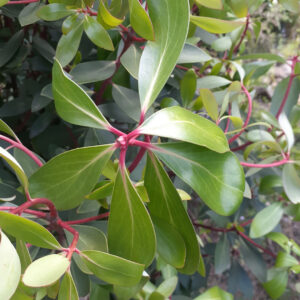
Grow edible species in public landscapes
If you are looking to grow native edible plants in a public landscape, Rees suggest planting those species where most of the plant is edible, so people can ‘nibble’ on them safely without consequence, e.g., Atriplex cinerea, Tasmannia lanceolata, and Carpobrotus rossii. “Tetragonia implexicoma (Bower Spinach), Tetragonia tetragonioides (Warrigal Greens) and Rhagodia candolleana (Berry Saltbush) are all plants where all parts of the plant can be eaten*. It is a way to break down that fear of ‘is it poisonous, or does it require extensive preparation’, and make it like nibbling the parsley in a public garden. Encourage the child in us all by welcoming people pulling up a strand of lomandra, e.g., Lomandra longifolia, Mat-rush or Sagg, to nibble the sweet white base of the stem,” Rees suggests.
Make some money too!
Rees says that crop farmers could satisfactorily grow many edible native plants as hedge plants or wind breaks to encourage pollinators, whilst also potentially providing a second source of income, e.g., honey production. “Kunzea ambigua makes great honey and can be pruned. Prostanthera rotundifolia (Round-leaved Mint Bush) is wonderful too, as are leptospermums and melaleucas. Plant a Leptospermum scoparium (Manuka/ninga) hedge for your windbreak, for your honey and your insects!” says Rees.
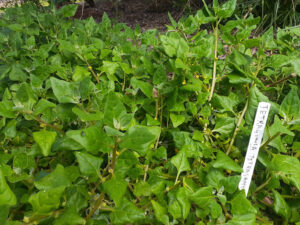
Palawa kani
Rees hopes that through her work she will inspire landscape designers, farmers, and other land carers to use edible plants to link the first Tasmanians and the historical Tasmanian landscape to the present landscape. Whilst updating her book Eat More Wild Tasmanian, Rees had the opportunity to work with language workers from the Tasmanian Aboriginal Centre who are working to revive Tasmanian Aboriginal language through palawa kani.
“Some of the palawa kani words are so delightful. I would love to see them more openly used in marketing and branding. Like our pepper (Tasmannia lanceolata). The name for pepper is tapu. Now you could not get a better word and it just really fits that plant. Kunzea (ambigua) is tinputina. The cider gum (Eucalyptus gunnii) or the cider from cider gum is wayalina. There are these lovely words that we could start using. I think that language is a way to heal. It is a way to bring the past into the present and the future,” concludes Rees.
NB. Plant names listed in bold are palawa kani, the language of the First Tasmanians. For more information about palawa kani, please refer to the Tasmanian Aboriginal Centre website: http://tacinc.com.au/programs/palaw
* Tetragonias do contain oxalates and nitrates, so are best eaten sparingly when raw according to Rees.
Gabrielle Stannus
Inwardout Studio
M: 0400 431 277
E: gabrielle@inwardoutstudio.com
Main photo: Rees and her partner Col have created the beautiful Murnong Wild Food Garden on a small suburban block in Wynyard, northern Tasmania, containing over 120 native edible plants
